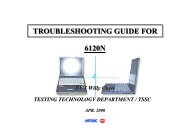Mitac 8080 Service Manual - laptop schematics, notebook ...
Mitac 8080 Service Manual - laptop schematics, notebook ...
Mitac 8080 Service Manual - laptop schematics, notebook ...
Create successful ePaper yourself
Turn your PDF publications into a flip-book with our unique Google optimized e-Paper software.
Signal Name Type Description<br />
SMI# I SMI# (System Management Interrupt) is asserted asynchronously by<br />
system logic. On accepting a System Management Interrupt, the<br />
processor saves the current state and enter System Management Mode<br />
(SMM). An SMI Acknowledge transaction is issued, and the processor<br />
begins program execution from the SMM handler.<br />
If SMI# is asserted during the deassertion of RESET# the processor will<br />
tristate its outputs.<br />
STPCLK# I STPCLK# (Stop Clock), when asserted, causes the processor to enter a<br />
low power Stop-Grant state. The processor issues a Stop-Grant<br />
Acknowledge transaction, and stops providing internal clock signals to<br />
all processor core units except the system bus and APIC units. The<br />
processor continues to snoop bus transactions and service interrupts<br />
while in Stop-Grant state. When STPCLK# is deasserted, the processor<br />
restarts its internal clock to all units and resumes execution. The<br />
assertion of STPCLK# has no effect on the bus clock; STPCLK# is an<br />
asynchronous input.<br />
TCK I TCK (Test Clock) provides the clock input for the processor Test Bus<br />
(also known as the Test Access Port).<br />
TDI I TDI (Test Data In) transfers serial test data into the processor. TDI<br />
provides the serial input needed for JTAG specification support.<br />
TDO O TDO (Test Data Out) transfers serial test data out of the processor. TDO<br />
TEST1,<br />
TEST2,<br />
TEST3<br />
5.1 Intel Pentium M Processor<br />
provides the serial output needed for JTAG specification support.<br />
I TEST1, TEST2, and TEST3 must be left unconnected but should have a<br />
stuffing option connection to V SS separately using 1-k, pull-down<br />
resisitors.<br />
THERMDA Other Thermal Diode Anode.<br />
THERMDC Other Thermal Diode Cathode.<br />
THERMTRIP# O The processor protects itself from catastrophic overheating by use of an<br />
internal thermal sensor. This sensor is set well above the normal<br />
operating temperature to ensure that there are no false trips. The<br />
processor will stop all execution when the junction temperature exceeds<br />
approximately 125°C. This is signalled to the system by the<br />
THERMTRIP# (Thermal Trip) pin.<br />
TMS I TMS (Test Mode Select) is a JTAG specification support signal used by<br />
debug tools.<br />
TRDY# I TRDY# (Target Ready) is asserted by the target to indicate that it is<br />
ready to receive a write or implicit writeback data transfer. TRDY#<br />
must connect the appropriate pins of both system bus agents.<br />
TRST# I TRST# (Test Reset) resets the Test Access Port (TAP) logic. TRST#<br />
must be driven low during power on Reset.<br />
<strong>8080</strong> N/B Maintenance<br />
Signal Name Type Description<br />
VCC I Processor core power supply.<br />
VCCA[3:0] I VCCA provides isolated power for the internal processor core PLL’s.<br />
VCCP I Processor I/O Power Supply.<br />
VCCQ[1:0] I Quiet power supply for on die COMP circuitry. These pins should be<br />
connected to VCCP on the motherboard. However, these connections<br />
should enable addition of decoupling on the VCCQ lines if necessary.<br />
VCCSENSE O VCCSENSE is an isolated low impedance connection to processor core<br />
power (VCC ). It can be used to sense or measure power near the silicon<br />
with little noise.<br />
VID[5:0] O VID[5:0] (Voltage ID) pins are used to support automatic selection of<br />
power supply voltages (Vcc). Unlike some previous generations of<br />
processors, these are CMOS signals that are driven by the Intel Pentium<br />
M processor. The voltage supply for these pins must be valid before the<br />
VR can supply Vcc to the processor. Conversely, the VR output must be<br />
disabled until the voltage supply for the VID pins becomes valid. The<br />
VID pins are needed to support the processor voltage specification<br />
variations.<br />
VSSSENSE O VSSSENSE is an isolated low impedance connection to processor core<br />
VSS. It can be used to sense or measure ground near the silicon with<br />
little noise.<br />
83





